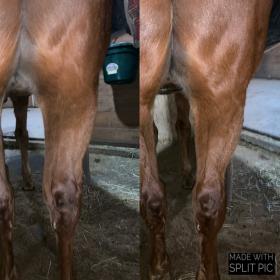Hello! Looking to hear about similar stories/treament with lymphangitis/cellulitis
My horse came in from the pasture about two weeks ago 3-legged lame. I noticed some swelling above the hock into his groin area (which is an odd place for swelling to me). Took some pictures/video for the vet as she is out of state for the season. She suspected he either had a scrape (which where wasn’t anything I could see) or sprain in his groin area that caused enzyme leakage down his leg. The next day his hock area blew up 3x the size.
I started him on SMZ’s and Dex along with cold hosing, and wrapping 2x a day. A week later, he is almost back to normal, and back on T/O.
Yesterday he had a morning massage and was super sore along his back and massage lady pointed out his opposite leg is off (I’m thinking from over-compensation).
Today I noticed he is super stiff again - I am just worried he might of done more than a sprain so I left a message with another vet to see if I can get him looked at.
Does cellulitis take a bit to go away - even if swelling is down? He is a 23 year old war-horse-type OTTB so I just think things are catching up to him, and hate to keep him cooped up.

